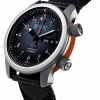Crystal polishing example
-
Recently Browsing
- No registered users viewing this page.
-
Topics
-
Posts
-
By Neverenoughwatches · Posted
I've noticed that some things are shipped from my country as well. Unlikely you will use any of the drills under 0.4mm, 0.4 seems about right for most re-pivot work for average watch sizes. Besides 0.3mm and under are extremely fragile and I found near impossible to sharpen, the flutes are so shallow and it's difficult to determine where to start grinding in the cutting and clearance angles once you've broken them. The cheap ones with the coloured size indicator collars have worked for me, though these ones might be better quality, they are 3x the price of the others. You guys really have to pay through the nose for this stuff. It would be interesting to find out how much cheaper it would be for you, if we acted as a go between . -
Sorry for the confusion but I was referring to the stud staying in the hole in the barrel.
-
Hi guys! I’ve just changed a watch battery for a friend of mine & he says it keeps stopping on him when he puts it on to go out, he says if he takes it off a pulls the crown & puts the crown back in the starts working again! Any ideas please! 👍
-
Sorry, when I said lift up: it tilts, lifts up on the side where the winding pinion is so the teeth no longer engage, down on the side where the mainplate is worn. I think it's worn there more than is immediately apparent in the photo; it's a bit dark. I shall get some photos of the crown wheel 😉 It's a Poljot 2614.2H. There is perhaps a bit of slop around the bushing, and some of the teeth may be slightly worn on the underside of the crown wheel. I'm not sure that if those issues are addressed it will fix the problem. I get the impression that having no support under one side is a bit of a design flaw that's asking for trouble.
-
The stud has a neck that is a little smaller in diameter than the end and the hole is keyhole shaped so the stud locks in and I wouldn't need to worry about the thickness of the tail pulling it out of the hole. It might be possible to remove the stud from the existing spring, but I don't know how I'd go about doing that in such a way that it would be reusable. Maybe work around it squeezing with pliers until the riveted end became small enough to pass through the spring? A few more higher magnification pics of the pin/stud:
-







Recommended Posts